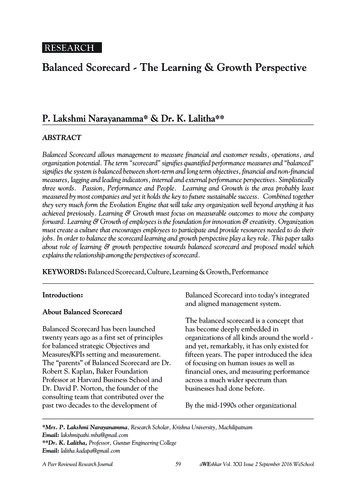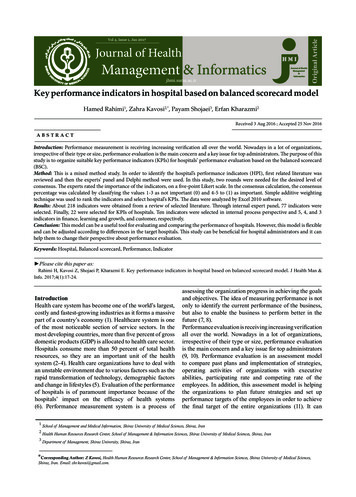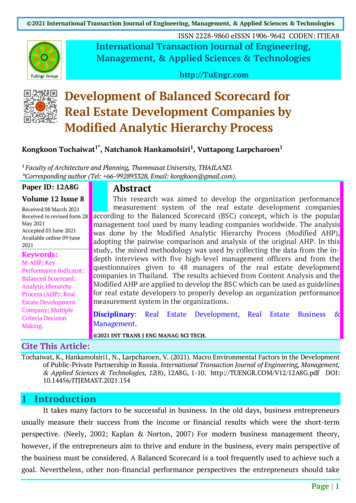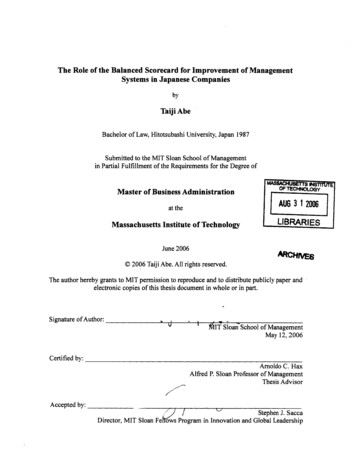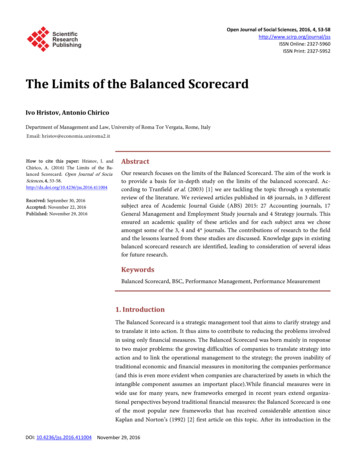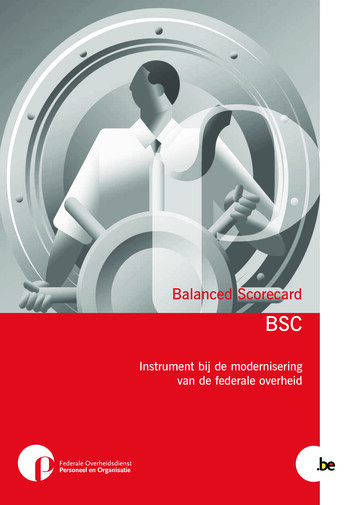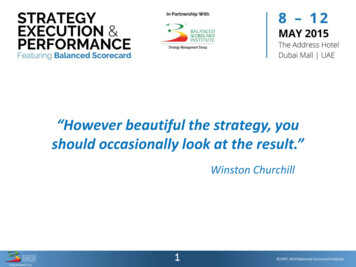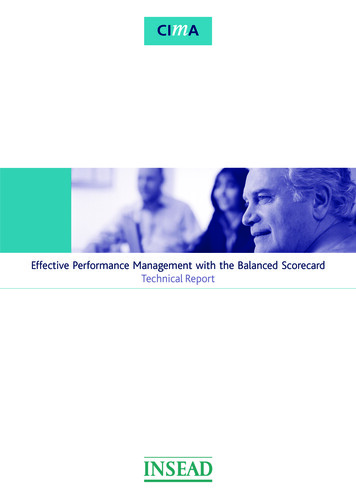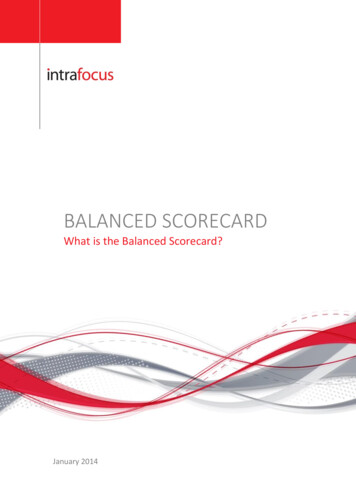
Transcription
BALANCED SCORECARDWhat is the Balanced Scorecard?January 2014
Table of ContentsTable of Contents . 1The Balanced Scorecard . 2The Four Perspectives . 3Key Performance Indicators (KPIs) . 4Scorecard Development . 5Sustaining the Scorecard . 5Culture and Connection. 5Balanced Scorecard Technology . 6Key Features (what to look for when selecting a solution) . 6Web . 6Ease of Use . 6Strategy Maps . 6Cascaded Scorecards . 6Balanced Scorecard Views . 6Communication . 7Alignment . 7Automated Scoring and Weighting . 7Initiative Management . 7Report Writing . 7Integration to Desktop Tools . 7Briefing Books . 7The Key Benefits . 8Appendix 1 – Strategy Map . 9Appendix 2 – Sample Scorecard . 10What is a Balanced Scorecard?Page 1
The Balanced ScorecardThe Balanced Scorecard is an organisational framework for implementing and managingstrategy at all levels of an enterprise by linking objectives, measures, and initiatives to anorganisation’s strategy. The scorecard provides an enterprise view of an organisation’soverall performance. It integrates financial measures with other key performance indicatorsaround customer perspectives, internal business processes, and organisational growth,learning, and innovation.It was originally published by Dr Robert Kaplan and Dr David Norton as a paper1 in 1992 andthen formally as a book ‘The Balanced Scorecard’ in 1996. Both the paper and the bookspread the knowledge of the Balanced Scorecard leading to its widespread success.The design of Balanced Scorecard concerns itself with the identification of a small number offinancial and non-financial objectives related to strategy. It then looks at measures, settingtargets for the measures and then measuring them on a regular basis to determine successor failure. Only when this is in place can strategic initiatives/projects can be considered. It isin this area that the Balanced Scorecard approach differs from other strategicmethodologies. It forces an organisation to think about how objectives can be measuredfirst and then what initiatives can be put in place to satisfy the objectives. The basis behindthis is to avoid creating initiatives/projects to early and measuring success based only oninitiative/project completion.There are two aspects of this activity that need to be brought out:1.The scorecard identifies a number of financial and non-financial objectives. Theseobjectives are few in number and are the critical sustainability or growth theorganisation. These objectives are related to four major categories to ‘balance’ thescorecard.2. Measurement is a crucial part of the activity. Each objective must be measurable. Thesemeasures are often referred to as Key Performance Indicators (KPIs). They also mustinclude both leading and trailing measures (see below ‘Key Performance Indicators’).The ‘balance’ that a Balanced Scorecardachieves is brought about by a focus onfinancial and non-financial measure that canbe attributed to four areas of anorganisation that are described asPerspectives. These are: Financial,Customer, Internal Business Processes andLearning & Growth.1It is interesting to note that although Kaplan and Norton published the first paper, they anomalouslyreferenced work by Art Schneiderman who is believed to be the creator of the Balanced ScorecardWhat is a Balanced Scorecard?Page 2
The Four PerspectivesQuestions often arise about the four ‘Perspectives’ described in the Balanced Scorecardmethodology. Why, given the plethora of activities any business may be involved in, shouldwe look at Financial, Customer, Internal Business Process and Learning and Growth? Whynot include “Health and Safety” if this of particular importance to a company? The answer is,of course, that there is nothing stopping us. The four perspectives are simply a framework.However, over decades of use it has become clear that they work and what’s more work verysuccessfully for most companies.In brief, the four perspectives are:1. Financial Perspective – The high level financial objectives and financial measures of theorganisation that help answer the question – How do we look to our shareholders?2. Customer Perspective – All objectives and measures that are directly related to theorganisations customers, focusing on customer satisfaction. To answer the question –How do our customers see us?3. Internal Business Process Perspective – The objectives and measures that determinehow well the business is running and whether the products or services conform to whatis required by the customers, in other words, what should we be best at?4. Learning and Growth Perspective – The objectives and measures concerning how wellour people perform, their skills, training, company culture, leadership and knowledgebase. All aspects that lead to continuous improvement. How can we improve and createvalue?The real value of the Perspectiveapproach is that it provides aframework to describe a businessstrategy and to focus on objectivesand measures that both inform usabout progress and allow us toinfluence activities to achieve thebusiness strategy. By using theframework as a diagram andphysically plotting the mostimportant objectives against specificperspectives it quickly focuses themind onto what is really important.The diagram to the right illustratesthis. What is interesting here is thatthe diagram has been created by asoftware tool. Software is not required to implement a Balanced Scorecard, but it helps.Furthermore, good software tools will allow the user to ‘drill down’ to the underlying datashould the need arise to question a specific activity, objective or performance measure.What is a Balanced Scorecard?Page 3
Key Performance Indicators (KPIs)Input to a Balanced Scorecard comes in the form of Performance measures, often referred toas Key Performance Indicators (KPIs). A KPI provides the most important information anorganisation requires to determine whether it is performing well or not. Unfortunately insome organisations KPIs have often become indistinguishable from operational measures.Organisations frequently take the view that everything should be measured and reported onand that these measure are KPIs. The clue however is in the title. A KPI is a Key performanceindicator. It is one of a small number of measures that are designed to reduce the complexnature of organisational performance and turn it into something that can be understoodeasily and acted upon quickly. Much is the same way as a doctor or nurse will monitor pulserate and temperature to determine the overall health state of an individual, with KPIs we areattempting to do the same for an organisation.Where should we start when defining KPIs to run an organisation effectively? The answer isentirely dependent on the strategy the organisation is deploying at the time. There has to bea direct relationship between what an organisation is trying to achieve (the strategicobjectives) and what is being measured to determine progress towards the objective.Clearly there will be a lot of operational measures and some of these may contribute data tothe Key Performance Indicators, but operational measures should be considered as‘housekeeping’ and ‘good practice’ and should not be confused with KPIs.The Balanced Scorecard gives us the framework to take a ‘balanced’ view across anorganisation and define strategic objectives in the four perspective areas together with theassociated KPIs. We have to be careful not to abstract to the highest level for every strategicobjective. For instance, it is laudable to have a strategic objective of ‘increased profitability’and also for ‘increased revenue’ and also for ‘increased shareholder value’ but to have allthree at such a high level will mean: 1. we are focusing on too much and 2. The KPIs requiredwill have to include just about everything the business is doing.It is better to focus on a small number of things where a structure can be put in place toinfluence/change behaviours and outcomes rather than to spread the workload so thinlythat nothing gets achieved at all. There is an old business strategy adage that states – if yourstrategy has 3 objectives you will succeed in all 3, if it has 4-10 objectives you will succeed in1-2, if it contains more than 10 objectives you will succeed in none – a simple case of the lawof diminishing returns.Finally, your KPIs must contain both leading and trailing measures. All too often weconcentrate on trailing measures. Why? Because they are easy to measure and they areaccurate. If I want to lose weight, I get on the scales, this gives me proof positive if I havesucceeded or not. It does not give me any help to succeed. If I measure how many times Igo for a run and how much I have eaten (and plan for this) then I have put in place twoleading measures that will help me succeed. Leading measures are harder to identify butthey are the only measures that can be influenced and therefore make a difference. Wemust not underestimate the importance of leading measures when creating a BalancedScorecard, defining our strategic objectives and our choosing our Key PerformanceIndicators.What is a Balanced Scorecard?Page 4
Scorecard DevelopmentOrganisations often begin the scorecard process by reading one of the many books on thetopic, attending a seminar, or doing web research. The Balanced Scorecard is a maturemethodology, and there are many resources for introductory education, training, andconsulting.Once the organisation has committed to the methodology, a third party facilitator (e.g. theBalanced Scorecard Institute) is often brought in to manage and bring an unbiased view tothe scorecard development process.Scorecard development can be veryrapid (five days), or as long as a year,depending upon the scope andcomplexity of the scorecard andorganisation. Many organisationselect to go with a rapid orintermediate approach, which insuresproject momentum while recognisingthat score-carding is an iterativeprocess. It is often better to makeand correct mistakes early while theorganisation is still excited about themethodology.Initial scorecard work is typicallydone with Microsoft Excel,PowerPoint, and/or Word. As the scorecard matures, the organisation should considerrolling out the methodology to the rest of the organisation. The goal is to connect allemployees to the organisation’s strategic objectives by using individual or group measuresthat are “on strategy.” This will help to institutionalise the new measurement frameworkwithin the organisation.Sustaining the ScorecardThe premise of the Balanced Scorecard is to provide an on-going, living framework that iscommunicated to the organisation. The scorecard needs to be sustainable and easy to rollout. Scorecards should leverage technology to provide automated links to measures, texts,and initiatives. Ultimately, the scorecard should become part of the organisation’s cultureand employees’ work experience. An easy to deploy and embrace web based system willallow for rapid roll-out and a sustainable scorecard initiative.Culture and ConnectionOnce the scorecard is developed, it is important to cascade it into the organisation. This willhelp link groups and individuals to the strategy. This is important because everyone needs tounderstand the cause-and-effect linkage of how he/she connects to the organisation’soverall performance. The goal is to translate the strategy into the staff’s “everyday speak”and identify measures of success that link to the overall strategic direction. As we connectand link, the culture of the organisation changes to be strategy focused.What is a Balanced Scorecard?Page 5
Using a software product will allow everyone in the organisation to clearly understand thecause-and-effect relationships so they can execute the strategy, align the organisation to thestrategy, and provide measurement and a continuous feedback mechanism to makecorrections to reach the desired strategic state.Balanced Scorecard TechnologyWhen choosing a Balanced Scorecard technology solution, an easy-to-use and powerful webbased solution that requires little or no IT involvement is essential. The solution should allowfor either an on-demand hosted solution (“score-carding as a service”) or local installation.Key Features (what to look for when selecting a solution)WebLook for a solution where development and deployment is done through a web browser.Cross-browser compatibility is preferred. Solutions using the latest J2EE technologies andAjax-style page updates are in-line with the latest developments in web technology.Ease of UseSelect a solution that is extremely easy-to-use. Choose aproduct that functions like desktop software using left clickto navigate and right click to develop. Also, look for productswhere data can be entered through the web interface,uploaded from a CSV file, or automated with a databaseconnection. Products should be as easy to use as browsing aweb page or shopping on-line.Strategy MapsThe key to a good Balanced Scorecard is the strategy map. Any product selected should havethe ability to create strategy maps with drill-down capabilities. Strategy maps often start outas a blank canvas to which you add images, shapes, text, and numbers to create a visualrepresentation of your data. Once you make a strategy map, however, the colours andnumbers automatically update based on the real data in your system. Strategy maps can alsobe used to track key metrics, visualise geographic data, and monitor trends.Cascaded ScorecardsOrganisation-wide Balanced Scorecard roll-outs require multiple cascaded scorecards. Thisallows the organisation to start at the top of the house and roll down into department,group, or even to the employee level. Look for products that allow for unlimited cascadedscorecards. Organisations should be able to drill-through to sub-scorecards or individualmeasure views. The entire organisation should be able to rollup information from multiple scorecards into higher-levelscorecards.Balanced Scorecard ViewsOrganisations should select a solution that has many differentways to visualise Balanced Scorecard information. Inadditional to the Strategy Maps discussed above, other viewsWhat is a Balanced Scorecard?Page 6
could include Navigational, Executive, Overview, Metric, and Analysis.CommunicationLook for products that allow for commentary on each level of the scorecard. It should bepossible to create comments that are either general or period specific. Alerts, such as whenyour metric needs updating (Notification), or when your metric turns Red (Push) areessential communication components.AlignmentA good solution will allow for Balanced Scorecard “Aligned Objectives” to be easily created,so that scorecards can show the performance of their own objectives and measures, or ofsupporting objectives across various scorecards.Automated Scoring and WeightingA scorecard tool should allow for automated scoring and weighting of structure elements.Build your structure, define the weighting, enter the measure values, and watch thescorecard “colour-up.”Initiative ManagementMany initiatives will come out of the Balanced Scorecard process. Look for products thathave full blown initiative management modules to manage these scorecard initiatives. Itshould be possible to create tasks and milestones and assign them to individuals or groups.All of the data should be visualised with sophisticated Gantt charts.Report WritingReporting is still necessary in any scorecardinitiative; getting the right information, tothe right people, and at the right time isimportant. A good solution will come with abuilt-in report writer that contains cannedreports like Red Metrics Report, GreyMetrics Report (missing values), and MetricComparison Report (compares metricswithin and across scorecards). The toolsshould also allow the user to pull data outof a scorecard database for ad hoc reporting. The report writer should allow for slicing anddicing of performance data and the ability to create exciting Flash presentation graphs.Integration to Desktop ToolsThe solution should allow the user to export graphs, reports, and scorecards to desktopapplications like Adobe Acrobat, Microsoft Word, Excel, and PowerPoint.Briefing BooksThe tool should create on-line briefing books to consolidate data for management, groups, orusers. Briefing books should be easy to set up by browsing the Balanced Scorecard modeland adding views, reports, and graphs. Once the briefing book is created, it should be easilyviewed on-line or exported to Adobe Acrobat, Microsoft PowerPoint, Word, or Excel.What is a Balanced Scorecard?Page 7
The Key BenefitsAfter 12 years since its introduction the Balanced Scorecard is now accepted by manyorganisations as the de facto tool to gather information, make decisions and implementstrategy. It has been estimated more than 50% of medium to large organisations use theBalanced Scorecard approach to performance management. The key benefits are: Improved organisational alignment and communication – The Balanced Scorecardapproach necessitates that the method is adopted by the whole organisation fromdepartment to division to enterprise. It becomes a single standard for all. Theimmediate benefit is a common language, common set of strategic objectives andcommon metric structure. This does not mean that the Balanced Scorecard has to beimplemented across an entire organisation immediately, indeed, the best approach is tostart small (usually at the executive level) and roll out over a defined period of time. Better strategic planning – The creation of a Strategy Map using the Balanced Scorecardmethodology forces an executive team to think hard about the relationship between astrategic objective, initiatives to fulfil the objective and the metrics required to both helpwith the success (leading measures) and determine actual success (trailing measures).The strategy map therefore becomes the cornerstone in strategic planning and has theadded benefit of being the communication medium of the strategy (and the way it willbe measured) to the rest of the organisation. Improved performance reporting overall – The Balanced Scorecard focuses the mind onthose things that need to be reported to the management and executive teams. Therewill be other things that need to be measured and reported upon, but the simple factthat the management and executive teams are clear on what they need will cause thewhole organisation to think about what is actually required and more importantly why.One of the obvious benefits of this activity is that unnecessary reporting will beeliminated.The Balanced Scorecard becomes an extremely powerful tool to ensure organisationalalignment, to improve communications, achieve much stronger strategic planning andultimately lead to a better preforming organisation that is in-tune with its business strategy.What is a Balanced Scorecard?Page 8
Appendix 1 – Strategy MapStrategy MapIn this example we cansee a mix of strategicinitiatives (ellipses) andmeasures (rectangles)colour coded torepresent thresholdse.g. Green - achieved,Yellow – potentially aproblem, Red – aproblem. There are alsotrend arrows/circlesshowing the previousstate.This strategy mapprovides a good visualrepresentation of thehealth of the businessWhat is a Balanced Scorecard?Page 9
Appendix 2 – Sample ScorecardPerspective ObjectiveFinancialMeasureIncrease Net Net OperatingOperatingProfitProfitTargetPriority Initiative10% end ofyearHighProjects greater 2 per month Highthan tionData OwnerIncrease Project Profitability Finance DirectorSales team to work withIndustry consultants topromote industry projectsConsultancyDirector andsales DirectorCustomer95% average Highsatisfaction scoreSupport DirectorAccounts withAccountManagers70% by year Medium Sales Director to assignendaccounts and balanceexisting workloadSales DirectorNumber ofindustrytemplates1 per month Medium Assign consultants todevelopment of 1 industrytemplate each per quarterManagingConsultantMaximumutilisation82% monthon monthOperationsDirectorLearningPeople want Number of CVsand Growth to work atreceivedIntrafocusHigh5 per month MedSet up n survey85% average Medon six monthsurveyConduct an employeeopinion survey every sixmonthsHR DirectorNumber of stafftrained inBalancedScorecard90%Highconsultantsby year endBalanced scorecard training HR Directorplan in placeAll staff to build a 100% bymanagementyear enddashboardHighTraining from Consultants set Managingaside in diaryConsultantThe Balanced Scorecard above shows that the three Strategic Objectives have moreinitiatives and measures than presented on the Strategy map. This is entirely appropriate,not all strategic initiatives and measures need to be reported at the strategy level. Theimportant factor should be that any ‘additional’ initiatives and measures should contributedirectly to the strategic initiatives and objectives.What is a Balanced Scorecard?Page 10
The Balanced Scorecard is a mature methodology, and there are many resources for introductory education, training, and consulting. Once the organisation has committed to the methodology, a third party facilitator (e.g. the Balanced Scorecard Institute) is often brought in to manage and bring an unbiased view to the scorecard development process.
